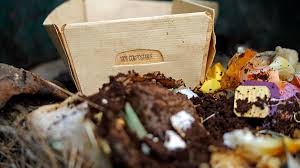
The Composting Consortium, an industry collaboration led by the Center for the Circular Economy at Closed Loop Partners, New York, has releases a report on whether or not certified, food-contact compostable packaging really breaks down in composting facilities. The report, Breaking it Down: The Realities of Compostable Packaging in Composting Systems, shares findings from an 18-month study on compostable plastic and fiber disintegration in diverse, in-field composting conditions.
The study tested more than 23,000 units of certified food-contact compostable packaging within large-scale industrial composting environments. This encompassed 31 types of fiber packaging and products and compostable plastic packaging and products across 10 composting facilities in the U.S.
“Alongside design and reduction as well as reuse and recycling, composting is an important solution for waste mitigation,” says Kate Daly, managing director and head of the Center for the Circular Economy at Closed Loop Partners. “Through this research, the Composting Consortium sheds light on what is needed for compostable packaging to have the greatest positive impact.”
The Composting Consortium reports that the food-contact compostable packaging market is posed to grow 16 percent annually in the U.S. until 2032, and approximately 70 percent of food processing composters accept and process some form of food-contact compostable packaging.
For compostable packaging to reach its full potential as a circular packaging solution, disintegration at end-of-life is critical, in tandem with consistent labeling and design that differentiates compostable and noncompostable packaging further upstream, as well as policies that incentivize robust composting infrastructure to process these materials, the consortium says.
The study found that overall, compostable packaging breaks down successfully at composting facilities that meet reasonable operational parameters, such as compost pile temperatures, moisture, oxygen and pH.
According to the study, compostable plastic packaging and products broke down successfully across five composting methods and all 10 facilities’ varying processing timeframes and operating conditions. It achieved 98 percent disintegration on average by surface area, which exceeds industry thresholds to achieve a 90 percent or higher disintegration. Compostable fiber packaging and products achieved 83 percent disintegration on average by surface area, meeting industry thresholds to achieve an 80 percent or higher disintegration. Findings showed that certain operating conditions, like turning, agitation and consistent moisture levels above 50 percent, support increased disintegration of fiber packaging and products.
“Brands and manufacturers must prioritize material selection and design and labeling for compostable packaging to achieve optimal performance in composting environments, which can then incentivize composters to accept food-contact compostable packaging materials at their facilities,” says Frank Franciosi, executive director of the U.S. Composting Council, an industry partner of the Composting Consortium. “As feedstock for composters becomes diversified and more complex, it's important for all entities within the supply chain to support consumer education on source separation of organics and reevaluate best management practices to support those composters who choose to accept compostable packaging, and this study is another tool for our industry to be able to start that process.”
The findings point to the viability of certified food-contact compostable packaging as an alternative packaging solution to single-use conventional plastic packaging. It also highlights the importance of ensuring that these materials align with available recovery infrastructure and the importance of expanding robust recovery pathways to divert compostable packaging from landfill, the Composting Consortium says.
The Composting Consortium says it will leverage these findings to help inform policymaking around compostable packaging, update best management practices for composting facilities and shape a field test standard for evaluating compostable packaging disintegration at composting facilities. Data from this study will be donated to the Compostable Field Testing Program (CFTP), which will launch an open-source database on the disintegration of compostable packaging.
The American Society for Testing and Materials (ASTM) International is developing an in-field test method for assessing disintegration of compostable items at composting facilities. Data from this study will be used to inform the draft field-testing method.
As the consortium moves into its next phase of work, it says the results of this study will shape its engagement and education efforts with composters, municipalities, regulators, brands and packaging manufacturers.
“Field testing for disintegration has been ongoing for three decades, and the Composting Consortium's work across the value chain has significantly advanced insights for the industry,” says Diane Hazard, executive director of the Compost Research and Education Foundation. “The collaborative approach and open-source data from this project both advances field testing methods and equips compost manufacturers and brands with the knowledge to better understand the variability of disintegration across different systems, all major steps towards successfully processing compostable packaging.”





